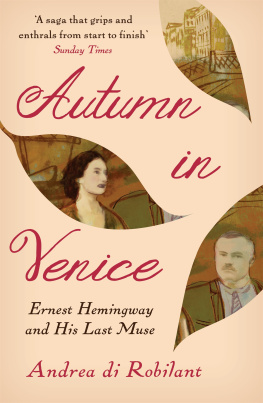THIS IS A BORZOI BOOK
PUBLISHED BY ALFRED A. KNOPF
Copyright 2011 by Andrea di Robilant
All rights reserved. Published in the United States by Alfred A. Knopf, a division of Random House, Inc., New York, and in Canada by Random House of Canada Limited, Toronto.
www.aaknopf.com
Knopf, Borzoi Books, and the colophon are registered trademarks of Random House, Inc.
Library of Congress Cataloging-in-Publication Data
Di Robilant, Andrea, [date]
Irresistible North : from Venice to Greenland on the trail of the Zen brothers / by Andrea di Robilant.1st ed.
p. cm.
This Is a Borzoi BookT.p. verso.
Includes bibliographical references and index.
eISBN: 978-0-307-59662-8
1. North Atlantic RegionDiscovery and explorationHistoriography. 2. Zeno, Nicol, d. ca. 1395. 3. Zeno, Antonio, d. ca. 1405. 4. Zeno, Nicol, 15151565. 5. ExplorersItalyBiography. 6. Faroe IslandsDiscovery and explorationHistoriography. I. Title.
E109.I8D57 2011
949.15dc22 2011000190
Jacket images: The Battle of Chioggia (detail) by
Alessandro Grevenbroeck, 1717. Museo Correr,
Fondazione Musei Civici di Venezia; the Zen map, Venice, 1558.
Biblioteca Marciana. Photo Pamela Berry
Jacket design by Evan Gaffney Design
v3.1
For my brothers Filippo and Tristano
Contents

The original Zen map, which I found glued to the back of the 1558 edition of Dello scoprimento It features Frisland, Estland, Islanda, Engronelant, Estotiland, Drogeo and Icaria. ()
(Click for an enlarged image of this map.)
Prologue
I CAME UPON this curious map in the most unexpected way. One day I was reading in the Biblioteca Marciana, in Venice, when an American tourist in shorts and T-shirt wandered into the hall holding a crumpled piece of paper. I offered to help as he was having some difficulty making himself understood by the clerk. He said he came from Madison, a small coastal town in Connecticut; he was on a pilgrimage to see the family palazzo of two Venetian brothers he claimed had crossed the Atlantic and reached the coast of North America at the end of the fourteenth century. He handed over the note on which he had scribbled their names: Nicol and Antonio Zen. They meant nothing to me at the time and the story sounded rather outlandish, but as the American was in a hurry to rejoin the group he was with, I pulled out from the open stacks a book on Venetian palaces, showed him a picture of a Palazzo Zen near the Frari Church and sent him on his way.
There are several Zen palaces in Venice: a few days later I was walking down the Fondamenta Santa Caterina, off the Campo dei Gesuiti (a brisk twenty-minute walk from the Frari), when I noticed a soot-covered plaque on the wall of a crumbling building:
A
Nicol e Antonio Zen
nel secolo decimoquarto
navigatori sapientemente arditi
dei mari nordicil
So this was the Palazzo Zen the American was looking for! It had none of the majesty of the great palaces that line the Grand Canal. Tufts of weeds tumbled out of the cracks in the marble. Loose electrical wires dangled from on high. Steel beams supported the walls like rusty old crutches. Even by Venetian standards, the building looked terribly worn. Yet the unusual mix of Gothic and Renaissance styles, embellished by Levantine motifs, gave it an air of shabby grandeur.
The next day, I put aside my research and checked the library catalog to see if I could find a reference to the Zen brothers and their mysterious voyages. Out of the Rare Book Collection came a dusty little volume, six inches by four, that seemed to have traveled to my desk straight from a sixteenth-century Venetian bookshop.
The book was printed in 1558 by a certain Francesco Marcolini. It was a travel narrative written in Italian, which was unusual because Latin was still the language of choice in publishing. The title was long-winded but alluring: Dello scoprimento dellisole Frislanda, Eslanda, Engrovelanda, Estotilanda & Icaria fatto sotto il Polo Artico da due fratelli Zeni (On the Discovery of the Islands of Frislanda, Eslanda, Engrovelanda, Estotilanda and Icaria made by two Zen brothers under the Arctic Pole).
The name of the author was not on the cover, but Marcolini, the printer, explained in the introduction that the book was written by the Magnificent M. Nicol Zen, a great-great-great-grandson of Antonio Zen, one of the two navigators. This Nicol Zen, whom I shall henceforth call Nicol the Younger to avoid confusion with his ancestor, was a well-respected statesman in Renaissance Venice and a minor historian whom Id come across on several occasions during my studies at the Biblioteca Marciana. The book, he claimed, was based on several damaged letters the brothers had sent home during their travels in the 1380s and 1390s, and which had remained in the family archives ever since.
Glued to the back of the little volume was a Carta da navegara nautical map. (For an enlargement of this map, see the final page of this book.) It was a wood-engraving with a rich, grainy texture. At first glance it looked like the sketch of an old treasure map, with oddly shaped islands and exotic place names. But I recognized the coastline of Scandinavia. The Shetland Islands were placed a little too close to the Norwegian coast. Iceland was roughly where it should have been, although a cluster of mysterious islets had been sprinkled along its eastern coast. Greenlands outline was traced with startling precision, but then a lumpy Nova Scotia seemed to have lost its bearings and was floating eastward, away from Newfoundland and the coast of New England. Strangest of all was a large, bulky island called Frisland (Frislanda in the text of the book), which the author placed above Scotland.
Even more intriguing than these obvious distortions was the general configuration of the map. It showed the North Atlantic as a semi-enclosed sea, in some ways a mirror image of the Mediterranean, and not as a wide-open expanse of water between two continents. Although the map was in many respects rather advanced by Renaissance standardsespecially with regard to Greenlandit seemed to reflect a late-medieval view of the North Atlantic in that it did not take into account the new geographical discoveries that, from 1492 onward, had revealed to Europeans the existence of the American landmass.
Travel narrative was very popular in the sixteenth century and the book sold well. After some initial probing I learned that several editions appeared in Venice in the following years. One of them reached Gerard Mercator, the great cartographer, in the German town of Duisburg; he used the Zens Carta da navegar to complete the first modern map of the world in 1569. An English translation was published in London by Richard Hakluyt, an influential geographer in Elizabethan England. Later I discovered that John Dee, astrologer, mathematician and close advisor to Queen Elizabeth I, seized on the Zen voyages in the 1570s to press the case for a British empire in North America. The Crown even sent Martin Frobisher on a fruitless journey to discover Frislanda and claim it for England.
As cartography became more accurate, the Zen map, like all maps of its period, lost much of its relevance. The book, on the other hand, continued to be read well into the nineteenth century. But in 1835 a Danish admiral, Christian Zahrtmann, stunned the world of geographers and mapmakers by declaring it was nothing but a tissue of fiction and that Nicol the Younger, the author, was a mischievous fablemonger. It took forty years for the Royal Geographical Society to publish a rebuttal of Admiral Zahrtmanns accusations; it was penned by Richard Henry Major, one of its most prestigious members. But the stain of forgery proved indelible. The book suffered several more attacks and by the end of the nineteenth century it had been fairly torn to shreds, a critic pronouncing it one of the most successful and obnoxious [literary frauds] on record.








